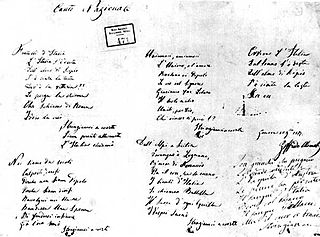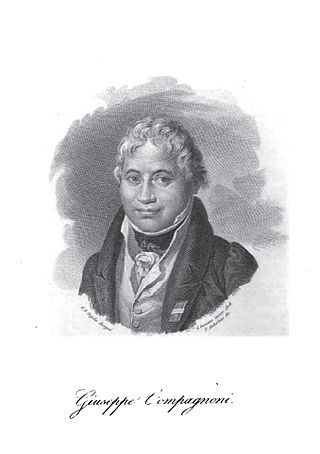
The unification of Italy, also known as the Risorgimento, was the 19th-century political and social movement that resulted in the consolidation of different states of the Italian Peninsula into a single state in 1861, the Kingdom of Italy. Inspired by the rebellions in the 1820s and 1830s against the outcome of the Congress of Vienna, the unification process was precipitated by the Revolutions of 1848, and reached completion in 1871 after the Capture of Rome and its designation as the capital of the Kingdom of Italy.

"Il Canto degli Italiani" is a canto written by Goffredo Mameli set to music by Michele Novaro in 1847, and is the current national anthem of Italy. It is best known among Italians as the "Inno di Mameli", after the author of the lyrics, or "Fratelli d'Italia", from its opening line. The piece, in a time signature of 4/4 and the key of B-flat major, consists of six strophes, and a refrain sung at the end of each strophe. The sixth group of verses, which is almost never performed, recalls the text of the first strophe.

The national flag of Italy, often referred to in Italian as il Tricolore, is a tricolour featuring three equally sized vertical pales of green, white and red, national colours of Italy, with the green at the hoist side, as defined by article 12 of the Constitution of the Italian Republic. The Italian law regulates its use and display, protecting its defense and providing for the crime of insulting it; it also prescribes its teaching in Italian schools together with other national symbols of Italy.

Reggio nell'Emilia, usually referred to as Reggio Emilia, or simply Reggio by its inhabitants, and known until 1861 as Reggio di Lombardia, is a city in northern Italy, in the Emilia-Romagna region. It has about 171,944 inhabitants and is the main comune (municipality) of the Province of Reggio Emilia.

The Province of Reggio Emilia is one of the nine provinces of the Italian Region of Emilia-Romagna. The capital city, which is the most densely populated comune in the province, is Reggio Emilia.

The history of Italy from 1559 to 1814 was characterized by the domination of foreign nations over Italy, and corresponds to the period that began in 1559 with the end of the Italian Wars and ended in 1814 with the fall of Napoleon. The following period was characterized by political and social unrest which then led to the unification of Italy, which culminated in 1861 with the proclamation of the Kingdom of Italy.

The Cispadane Republic was a short-lived client republic located in northern Italy, founded in 1796 with the protection of the French army, led by Napoleon Bonaparte. In the following year, it was merged with the Transpadane Republic to form the Cisalpine Republic. The Cispadane Republic was the first Italian sovereign State to adopt the Italian tricolour as flag.

The emblem of the Italian Republic was formally adopted by the newly formed Italian Republic on 5 May 1948. Although often referred to as a coat of arms, it is an emblem as it was designed not to conform to traditional heraldic rules. The emblem is used extensively by the Italian government.

Mapei Stadium – Città del Tricolore is a multi-purpose stadium in Reggio Emilia, Italy. It is currently the home ground of U.S. Sassuolo of Serie A and A.C. Reggiana of Serie C.

The Sala del Tricolore, formerly the Patriotic Hall, is an historical hall that currently serves as the council chamber of the comune of Reggio Emilia, northern Italy. It was designed by the architect Lodovico Bolognini as the archive of the ducal family of Este. In the Sala del Tricolore, on 7 January 1797, the flag of Italy was born, hence the name of the hall. Adjacent to the room is the Tricolour Flag Museum, whose collection is made up of relics related to the Italian flag.

The Flags of Napoleonic Italy were the green, white and red tricolour flags and banners in use in Italy during the Napoleonic era, which lasted from 1796 to 1814. During this period, on 7 January 1797, the green, white and red tricolour was officially adopted for the first time as a national flag by a sovereign Italian state, the Cispadane Republic. This event is commemorated by the Tricolour Day.
National symbols of Italy are the symbols that uniquely identify Italy reflecting its history and culture. They are used to represent the Nation through emblems, metaphors, personifications, allegories, which are shared by the entire Italian people.

The national colours of Italy are green, white, and red, collectively known in Italian as il Tricolore. The three Italian national colours appeared for the first time in Genoa on 21 August 1789 on the cockade of Italy shortly after the outbreak of the French Revolution, on 11 October 1796 they were used for the first time in Milan on a military banner, while on 7 January 1797 in Reggio Emilia they appeared for the first time on a flag.

Raffaele Tafuri (1857-1929) was an Italian painter. He was born on January 27, 1857, in Salerno. He died in 1929 in Venice.

Lombard nationalism is a nationalist, but primarily regionalist, movement active primarily in Lombardy, Italy. It seeks more autonomy or even independence from Italy for Lombardy and, possibly, all the lands that are linguistically or historically Lombard. During the 1990s, it was strictly connected with Padanian nationalism.

The cockade of Italy is the national ornament of Italy, obtained by folding a green, white and red ribbon into a plissé using the technique called plissage (pleating). It is one of the national symbols of Italy and is composed of the three colours of the Italian flag with the green in the centre, the white immediately outside and the red on the edge. The cockade, a revolutionary symbol, was the protagonist of the uprisings that characterized the Italian unification, being pinned on the jacket or on the hats in its tricolour form by many of the patriots of this period of Italian history. During which, the Italian Peninsula achieved its own national unity, culminating on 17 March 1861 with the proclamation of the Kingdom of Italy. On 14 June 1848, it replaced the azure cockade on the uniforms of some departments of the Royal Sardinian Army, while on 1 January 1948, with the birth of the Italian Republic, it took its place as a national ornament.

Marco Giuseppe Compagnoni was an Italian constitutionalist, writer and journalist, considered the "father of the Italian flag", since he was the first to propose the official use of the Italian tricolour for the flag of a sovereign Italian state, the Cispadane Republic, on 7 January 1797.

The flag of Emilia-Romagna is one of the official symbols of the region of Emilia-Romagna, Italy. The flag shows the coat of arms adopted in 1989 in the variant with green writing and red bar on a white background. Currently the banner does not enjoy official legislative status, but is currently used in ceremonial context since the end of the 90s: for November 4, 1995, the national day of the Armed Forces, the President of the Republic Oscar Luigi Scalfaro wanted to exhibit in a Sala del Quirinale the flags of all Italian regions, but many of them, including Emilia-Romagna, did not have specific laws regarding the adoption of a banner. Therefore, several provisional versions were developed to respond to the request of the Head of State. In this case the flag was outlined by overlapping the official coat of arms on a simple white background in the shape of a rectangle of proportions 2:3. The figure, placed symmetrically in the center of the element, occupies a total of 3/5 of the height of the entire field and the colors, as well as the graphics, correspond to the indications and standards dictated by the coordinated image manual. The banner, at first used exclusively on rare occasions, has progressively spread over time and today is displayed by various public administrations and institutions within the Emilia-Romagna territory as well as in the official headquarters of the region in Bologna and in the buildings occupied by the Legislative Assembly and the council.

The Tricolour Flag Museum is located in Reggio nell'Emilia, the city that saw the birth of the Italian flag in 1797, inside the town hall of the city, adjacent to the Sala del Tricolore, whose collection is made up of relics related to the Italian flag.

Holy Family with the Infant Saint John the Baptist and Saint Mary Magdalene is a 1508-1512 oil on panel painting by Palma Vecchio. It was in archduke Leopold William of Austria's collection in Brussels from 1653 to 1662 before being moved to the Imperial Galleries in Vienna, before finally being exchanged for another work with the Uffizi in Florence in 1793, where it is now inventory number 950.
























